Adam Yamey's Blog: YAMEY, page 136
February 4, 2022
Agatha Christie lived here

HAMPSTEAD’S LAWN ROAD Flats, better known nowadays as the Isokon Flats, was built in the 1930s as an experiment in communal living. This modernistic building was home to artists, writers, architects, and others. Many of its tenants were intellectuals fleeing from Nazi Germany. Amongst its many inhabitants were Henry Moore, Agatha Christie, and Walter Gropius. Unintentionally, it also became a centre for Soviet Russian espionage activities. You can read about this amazing place and a great deal more about Hampstead in my new book, “Beneath a Wide Sky: Hampstead and its Environs”: https://www.amazon.co.uk/BENEATH-WIDE-SKY-HAMPSTEAD-ENVIRONS/dp/B09R2WRK92/
February 3, 2022
Young Poland
WILLIAM MORRIS (1834-1896) was amongst other things a textile designer, printer, writer, and a Socialist. He was closely associated with the British Arts and Crafts Movement which lasted from the late 19th century into the early 20th. This movement can be considered part of the wider Art Nouveau/Jugendstil movements on the mainland of Europe. Morris’s Socialist leanings were embodied in his desire to make beautiful objects available to people of all social classes. His creations were not purely aesthetic but also politically motivated.
As a child, Morris lived in a grand Georgian house in northeast London’s Walthamstow district between 1848 and 1856. This became the home of the publisher Edward Lloyd (1815-1890) between 1857 and 1885. Today, this building is the home of the William Morris Gallery, which has several rooms dedicated to exhibits illustrating the achievements of Morris and his movement. It also hosts temporary exhibitions. One of these, which we visited today on its final day, the 30th of January 2022, was aptly housed in a building dedicated to such an important person in the Arts and Crafts Movement.

Between 1795 and soon after WW1, Poland did not exist as an independent country; its territories were divided amongst the Russian, Austrian, and Prussian empires. Polish language and nationalistic aspirations were suppressed. Between about 1890 and 1918, the Young Poland movement flourished. It was a wide-ranging artistic development with many similarities to what was happening in the Arts and Crafts Movement that was initiated by John Ruskin and William Morris. Just as Morris was concerned that industrialisation and mass-production might lead to the loss of beauty associated with the works of traditional craftsmen; this was also the worry expressed by members of the Young Poland movement. Like Morris and his collaborators, Young Poland was also hoping to expose all social groups to objects of beauty. As a placard in the exhibition explains:
“Like William Morris, Young Poland makers believed in cultural democracy: that everyone had a right to beauty in daily life; the spiritual benefits of handiwork; and the equal value of all the arts irrespective of materials or techniques used.”
The Young Poland movement had another motive in addition to making beauty available for all. Many of their creations illustrated and celebrated aspects of Polish tradition and national pride. It was not only an artistic movement but a fairly subtle way of expressing the desire for independence of the Polish people and Roman Catholicism during a time when more overt nationalistic expressiveness would have attracted adverse reactions from the invaders, who were then dominating the Poles.
The exhibition was large enough to be spread over several rooms. The exhibits, most of which came from collections in Poland, are stylistically similar to what was produced in the British Arts and Crafts Movement are beautiful as well as being typically Polish in subject matter. The artists and the various subdivisions of the Young Poland movement are summarised in the gallery’s website (https://youngpolandartsandcrafts.org.uk/exhibition/). One of the many works, which I liked and that illustrates the nationalist sentiments of Young Poland, was a painting, “Dawn at the Foot of Wawel Hill”, by Stanisław Wyspiański (1869-1907). He was, like Morris, a polymath. The picture depicts Wawel Hill in Krakow during the time when this area of the city was being used as a barracks by the Austrian occupiers. The picture is in muted drab colours except for one bright light on a lamppost. The glowing lamp represents the Poles’ eternal hope for independence, which was only achieved in 1918, 24 years after the painting was completed.
One room in the exhibition is dedicated to drawings and paintings by the playwright Maria Pawlikowska-Jasnorzewska (1891-1945), who died in Manchester (UK) having come to England from Poland in 1939. Although she would have been too young to have been a member of Young Poland, her rarely seen artworks were included, according to the gallery’s website, because:
“These bold and intimate watercolours feature fantastical and macabre elements inspired by Polish folk traditions.”
It was these traditions that also are reflected in the works by the Young Poland creators.
The exhibition was both fascinating and uplifting. I am glad we managed to see it and hope that it will be held again somewhere so that all of you reading this will not have to miss out on what was a wonderful experience.
February 2, 2022
Out of town
THE GREAT SAMUEL Johnson (1709-1784) is supposed to have said to James Boswell on the 20th of September 1777:
“Why, Sir, you find no man, at all intellectual, who is willing to leave London. No, Sir, when a man is tired of London, he is tired of life; for there is in London all that life can afford.”

Now, 245 years later in 2022, I largely agree with Dr Johnson, but not completely. Every now and then, it is wonderful to leave London in search of the open countryside, fresh air, wide expanses of sky, and a different way of life. Equally, it is satisfying to return to the city feeling refreshed and, sometimes, having been away from it, seeing familiar things in a new light. Our excursions from London have ranged from several months to several hours. The latter, shorter outings, have been invaluable during the recent period when because of covid19 travelling abroad has been difficult, to say the least.
One of our current favourite destinations for brief outings is the tiny village of Abingdon Piggots in southern Cambridgeshire. Although it is only about 90 minutes’ drive from central London, it feels as if it is almost in a different world from the metropolis. Despite being close to Baldock and Royston, the village seems as if it is in the deepest countryside. It has not more than 60 well spread-out houses, a church, and a hostelry called the Pig and Abbott.
The Pig and Abbott is run by Pat and Mick. It is a traditional country inn where one can enjoy a drink as well as eating superbly cooked, tasty food. We have visited the pub at least six times since we first discovered it in July 2020. Each time we go there, we are welcomed like old friends. I suppose we have become regarded as ‘regulars’. Mick told me that most of the regulars come from the area around the village. Of the 60 or so households on the village, only about 10 use his pub. I asked him whether we were amongst his furthest customers. He told me that we were, but one of his regulars, who lives in Alaska, always drops in when he visits Cambridge, where he has work colleagues.
After a hearty meal at the Pig and Abbott, we always take a stroll along Church Lane to see the small church in which there are graves of members of the local Piggott family. The lane is flanked by fields in which one can watch sheep and horses grazing. There is hardly any sound to be heard except birdsong.
Pleasant as is this bucolic scene, it would not suit me to live in it for more than a day or two. I am an urban creature at heart and the humdrum of city life suits me well. My childhood was spent amongst gardens and trees in the Hampstead Garden Suburb in north London, yet I never enjoyed the place as much as central London, which I began visiting with my parents at a young age. I guess that although I enjoy my occasional forays outside London, I cannot disagree with what Johnson said to Boswell all those years ago.
February 1, 2022
The year Albania proclaimed independence
IN WARWICK, I chanced upon a fascinating book in a charity shop. It is Part 2 of “Stanley Gibbons Priced Catalogue of Stamps of Foreign Countries 1912”. When it was published, it could be purchased for as little as half a crown (2/6, which is 12.5 pence). I paid a lot more for it, but not an excessive amount.
I felt compelled to buy it because of its date and my interest in Albania. For, on the 28th of November 1912, the independence of Albania was proclaimed in the seaside town of Vlorë. Albania’s independence was formally recognised when the Treaty of London was signed in July 1913. The catalogue I bought in Warwick was published some time in 1912 and most likely before independence was proclaimed. As far as the publishers and the compilers were concerned, what is now Albania was still part of the Ottoman Empire.
The index of the catalogue contains an entry for “Albania (Italian P.O.)”. This needs some explanation. Throughout the Ottoman Empire, there were postal services operated by foreign (i.e., not Ottoman) countries. A website (www.levantineheritage.com/foreign-pos...) reveals:
“In the 18th century, foreign countries maintained courier services through their official missions in the Empire, to permit transportation of mail between those countries and Constantinople [sic] the Empire capital. Nine countries had negotiated Capitulations or treaties with the Ottomans, which granted various extraterritorial rights in exchange for trade opportunities. Such agreements permitted Russia (1720 & 1783), Austria (1739), France (1812), Great Britain (1832) and Greece (1834), as well as Germany, Italy, Poland, and Romania, to maintain post offices in the Ottoman Empire. Some of these developed into public mail services, used to transmit mail to Europe. The Ottoman Empire itself did not maintain a regular public mail service until 1840, when a service was established between Constantinople and other major cities in the country and this was slow to develop and expand. The gap in this capacity was very much filled with the various foreign post offices which continued functioning right till the beginning of WWI in 1914 …”
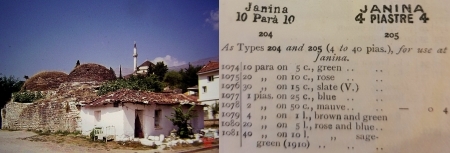 Left: Ioannina in the 1970s. Right: examples of over-printing texts
Left: Ioannina in the 1970s. Right: examples of over-printing textsHence, the entry in the catalogue’s table of contents. I turned to the page listed and found the section on Albania. The Italian Post Offices in the Turkish (Ottoman) Empire issued stamps, to quote the catalogue, which:
“…surcharged or over-printed for use in Italian post offices abroad.”
These stamps were the regular issues but, to quote the catalogue:
“… distinguished by the removal of some details of the design, over-printed with Type…”
Different Italian stamps were overprinted with names of places and a Type number. For example, Italian stamps were over-printed with: “ALBANIA. 10 Para 10. 201” (where ‘10 Para’ is a monetary denomination and ‘201’ is the Type number), or “Durazzo. 4 PIASTRE 4. 205”, or “Valona, or other place names. 10 Para 10. 208”. Durazzo and Valona being the Italian for the Albanian names Durres and Vlore.
Within the Albanian section of the catalogue there is also an illustration of the over-printing “JANINA. 4 Piastre 4. 205”. Janina is the name of a town now in Greece, Ioannina (Ιωάννινα). In 1912, this town was not in what was then Greece, but in the Pashalik of Janina, part of the Turkish Empire. In February 1913, following the battle of Bizani in the First Balkan War, the town was absorbed into Greece. Many Albanians still consider that by rights Ioannina should be a part of a Greater Albania. The large Albanian population in the town was forcibly reduced by population exchanges in the early 1920s and also the pre-WW2 Greek government’s policy of strongly encouraging people of Albanian ethnicity to regard themselves as Greeks. When I visited Ioannina in the 1970s, there were the remains of Turkish buildings but many of them were in a sad condition. I do not know whether they have been restored since then.
My purchase in Warwick has proved to be of interest. It records the state of postage stamps on the eve of great changes that were about to happen in the Balkan peninsular as well as illustrating aspects of European colonialism, both political and economic.
January 31, 2022
Problems! Problems! Publishing
ALL OF MY books have been self-published. Until recently, I used a ‘print-on-demand’ website called lulu. The process involved first writing my manuscript and formatting the text and any illustrations on Microsoft’s Word software, using a template (for the size of the book) downloaded from lulu. When I was happy with what I had produced, I was able to upload it to lulu’s website. Then, the fun began. Lulu converted my Word document into a .pdf file and when that was done, I could download the .pdf to proofread and make other checks. Almost always, something was lost in translation: what appeared in the .pdf was far from what I wanted. So, endlessly I had to keep adjusting my Word file and uploading it to see whether the latest version produced what I wanted in the lulu generated .pdf. It was tedious and somewhat nerve-wracking to say the least. Then, last summer, disaster struck.

I had just completed the manuscript for a book about west London and was looking forward to uploading it to lulu. It did not take more than a couple of minutes to discover that lulu was no longer accepting manuscripts in the form of Word files. The requirement was to prepare a correctly formatted .pdf file. I was stumped. I had no idea how to do this and felt despondent because I then believed that I might not be able to publish another paperback myself.
Many months passed. Then, while I was perusing some articles on the lulu website, I discovered that one can format .pdf files using software such as Adobe’s InDesign. I investigated this and found it to be quite costly. However, soon I became aware that there is a cheaper option, Serif’s Affinity Publisher, which I bought and downloaded.
At first, Affinity looked impenetrable but there are many on-line tutorials, which I watched before tackling the software. After a few false starts, I began to get the hang of the programme’s basics. Using the relevant template downloaded from lulu, I then inserted the text from my Word manuscript into the Affinity system. After several days of moving the text about and inserting some illustrations and the page numbering, I produced something that looked acceptable. I converted the Affinity file into a .pdf file using the software’s ‘export’ function. Then, with some trepidation, I uploaded my new Affinity-generated .pdf file on to the lulu site. To my great joy, the proof that lulu produced was exactly as I wanted it. So, the Affinity software has proved to be up to the job.
Having found a method to upload to lulu without the problems caused by lulu’s conversion from Word to .pdf, I moved on to finishing and pricing the book. To my horror, I discovered that lulu has increased its prices dramatically. The book, which I created could not be sold to the public for less than £ X plus at least £3.99 postage, which in my opinion was forbiddingly excessive for a book of the size I had made.
Then, I looked at Amazon, which has a book publishing service. Using a new ISBN, I uploaded my .pdf, and after looking at the proof they generated, I looked into the pricing. To my great delight, they can sell the paperback at 58% of lulu’s price excluding postage, which does not always need to be paid. I have seen a copy of the book produced by Amazon and I am happy with its quality. Amazon have captured me from lulu when it comes to book publishing.
January 30, 2022
Republic Day
AFTER OUR HONEYMOON in the south of India, we returned to Bangalore, where we disembarked from an overnight bus from Ernakulam (in Kerala) at about 4 am on the 26th of January 1994. Several hours later and incredibly bleary-eyed, we joined many other residents at a gathering in a courtyard of the apartment block in the city’s southern suburb of Koramangala. Mr Zafar Futehally (1920-2013), a noted naturalist and one of the senior tenants, stood by a flagpole and made a brief speech. Then, the flag of India was raised, and everyone dispersed. It was Republic Day, the significance of which was unknown to me back in 1994, when I made my first visit to India.
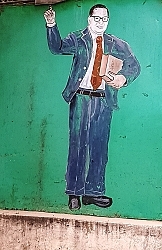 Ambedkar in Bangalore
Ambedkar in BangaloreNow, I know that on the 26th of January 1950, two and a half years after India became independent, the Constitution of India came into effect and India became a republic, having briefly been a Dominion since the 15th of August 1947. The Constitution was drafted by a committee that was led by Dr Bhimrao Ramji Ambedkar (1891-1956). After leaving school, he was educated at the University of Bombay, then at Columbia University in NYC, and then at the London School of Economics (‘LSE’). While in London, he qualified as a barrister as a member of Gray’s Inn.
Long after 1994, I learned that Ambedkar had lived in a part of London with which I am familiar. He resided in a house near Primrose Hill and Chalk Farm, where the Roundhouse is located. In my recently published book “Beneath a Wide Sky: Hampstead and its Environs”, I wrote:
“Another reformer and patriot lived near Regents Park Road. He was Dr Bhimrao Ramji Ambedkar (1891-1956), who championed India’s Dalits (‘untouchables’) and formulated the Constitution of India. Between 1920 and 1922 while he was studying at the London School of Economics and for the Bar, Ambedkar lived in a house at 10 King Henrys Road near Regents Park Road. In 2015, the house was bought by the Government of Maharashtra and was then converted into a memorial to Ambedkar. It is open to the public. Visitors can learn about Ambedkar from the well-captioned photographs on the walls of the rooms that they can wander through. The upper floor contains a re-construction of Ambedkar’s bedroom including a four-poster bed, some of the great man’s books, and an old pair of spectacles, which might have belonged to him. Other rooms contain shelves of books and various memorials to Ambedkar. There is also a commemorative plaque to India’s present Prime Minister Narendra Modi, who inaugurated the memorial house in November 2015. The garden contains statue of Ambedkar clutching a book (the Constitution) in his left hand. A few years ago, neighbours of the Ambedkar house complained about it, concerned that it would attract swarms of tourists.”
Although he could never have met him, Ambedkar’s home in King Henry’s Road was not far from the house in which Friedrich Engels (1820-1895) lived for several years.
The statue portraying Ambedkar statue in the garden of his former London home is typical of those found all over India. Apart from helping to give birth to India’s Constitution, Ambedkar campaigned for the rights of the Dalits (the ‘Untouchables’), as mentioned in the quote above. The Dalits were excluded from the four caste Varna system of Hinduism and considered by many Hindus as the lowest of the low, fit only for menial tasks that members of other castes would not deign to consider doing. Ambedkar, born into a Dalit caste, campaigned actively for the ending of social discrimination against this class of people. Mochis (cobblers/shoe repairers), who handle leather, are often Dalits. The best place to find a mochi is on the pavement beside a road. Sometimes, they sit on the ground surrounded by their tools and footwear awaiting repair. In other cases, they work from little stalls that can be locked up when they are not at work. These stalls often bear images of Ambedkar in honour of the man who did much to help the Dalits. What with the huge numbers of statues of him and of portraits on the stalls of mochis, Ambedkar must rival Gandhi as being one of the most frequently portrayed politicians of modern India.
So, every Republic Day, it is appropriate to celebrate the birth of the republic and the adoption of the Constitution, but we should not forget to raise our hats and flags to Ambedkar, the brilliant man who did far more than father the Constitution.
January 29, 2022
Letting off gas
THIS IS AN UNSAVOURY subject. So, you have been warned.
On our first visit to Baroda (Vadodara) in the western Indian state of Gujarat a few years ago, I noticed several tall cast-iron structures resembling lamp posts, except that they were topped with curious objects. Each of these tall streetside poles is topped with spheres, each with four cylindrical projections. Beneath each sphere, there is an arrow. I was puzzled by these objects. So, I posted pictures on Facebook and asked if any of my friends knew what purpose these things serve or used to serve. I received several ingenious suggestions, none of which turned out to be correct.
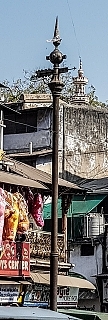 Baroda (Vadodara)
Baroda (Vadodara)Having seen these items in Baroda (and also in Bombay and Ahmedabad), I began noticing similar structures in London. None of the examples in London are topped with the sphere and arrow, but in other respects they are not particularly different from those I saw in India. Eventually, I learned that they are all examples of ‘stink pipes’. There are many fine specimens, disused I believe, dotted around London. Recently, I was reminded of those I saw in India when I saw a couple near Chiswick Mall in west London.
It was not until after about 1858 that sewage began being channelled through enclosed sewers in London, an improvement instigated by London Metropolitan Board of Work’s Chief Engineer Joseph Bazalgette (1819-1891). Sewage is waste matter, which tends to decompose. The products of decomposition include noxious gases such as for example hydrogen sulphide, carbon monoxide, ammonia, and methane. Some of them are highly inflammable and all of them increase in pressure as the sewage flows through the sewers. The stink pipes serve(d) as vents through which the gasses building up could escape from the sewers. They tend to be tall so that the gases blow off high above ground level where there are more likely to be breezes that can disperse the gases. Without adequate venting, the gaseous vapours can become dangerously explosive. Returning to Baroda, where the stink pipes are topped with spheres. The gases escape through the conical projections and, I have learned, the arrows indicate the direction of the sewer running beneath them and which way the sewage is flowing.
January 28, 2022
The admiral and the antiques shop
THE BATTLE OF Portobello was fought between the British Navy and the Spanish in November 1739. It was an event during the War of the Austrian Succession. The battle’s aim was to capture the port of Portobello in Panama from the Spanish. The British were victorious.
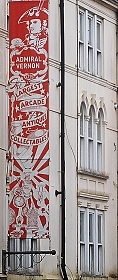
I have been walking along Portobello Road frequently for over a quarter a century. Each time, I have passed a series of neighbouring shops collectively known as Admiral Vernon Antique Market. I thought it was an odd name until today when I noticed that it is close to an alley called Vernon Yard. Then, the penny dropped, and I began thinking about the choice of the shop’s name – an admiral on Portobello Road.
Admiral Edward Vernon (1684-1757) was born in London. He joined the Royal Navy in 1700, aged 12, and rose through the ranks. One of his many achievements was the creation of the name ‘grog’ for the commonly consumed drink consisting of rum diluted with water. Also, he made improvements to the methods of naval manoeuvres and the welfare of sailors. Another of his claims to fame was that along with Lieutenant-General Thomas Wentworth (c1693–1747) he led the British forces that captured Portobello.
Knowing this makes sense of the name of the antique shop and the name Vernon Yard. The shop and the dreary little alley are not the most magnificent of memorials to Edward Vernon. There is a more elegant one in Westminster Abbey. The most impressive item commemorating the admiral is the estate of Mount Vernon in Virginia (USA), which was once owned by George Washington’s family. It was named after Edward Vernon because one of Washington’s brothers, Lawrence (died 1752), had been under Vernon’s command during the capture of Portobello.
January 27, 2022
A NEW book about Hampstead in north London

AVAILABLE FROM AMAZON WEBSITES:
e.g.: https://www.amazon.co.uk/dp/B09R2WRK92
Hampstead is one of the highest places in London. There, the heavens are vast
and wide. Beneath this expanse of sky is an area with an eventful past and a
vibrant present. This book takes a fresh look at the locality and shows that
Hampstead is richly imbued with historical memories and has been home to a
multitude of fascinating and noteworthy people. Many books have been written
about Hampstead. Doubtless, there will be more. This one is different. It looks
at Hampstead from unusual as well as familiar viewpoints and gives the reader
a richer appreciation of what makes the place both delightful and intriguing.
This volume explores a wide variety of subjects, familiar and obscure, as well as
some which have never been described in other books about the locality. Here
is a fresh and at times quirky look at this place on a hill, one of London’s
treasures: a district, which is familiar to many people, yet full of surprises.
Although the bulk of this book is about Hampstead, there are also sections
describing some of its environs.
By reading this book, you can find out why John Constable, Samuel Johnson, Boy George, Mohammed Ali Jinnah, Mahatma Gandhi, Peter Sellers, Henry Moore, Maxim Litvinov, General de Gaulle, Stanley Spencer, Thomas Masaryk, Lee Miller, Agatha Christie, Jim Henson, Ian Flemming, Ernő Goldfinger, and many others, both famous and familiar, were all connected with Hampstead.
The book has several sections:
1. a brief survey of Hampstead’s general history and geography.
2. an introduction to Hampstead’s main thoroughfares with some
reminiscences of the area as it was during my youth.
3. the largest section of the book is a collection of chapters about
various aspects of Hampstead’s past and present. Recently, a friend of mine
bemoaned the fact that Hampstead High Street and Heath Street are lined with
branches of shops and cafés that can be found all over London. He is right. So,
if you wish to capture the true character of Hampstead, you need to stray into
the side streets and explore, which is what I hope this book will stimulate you to
do.
4. The last few sections of the book deal with some places of interest near to
Hampstead: Primrose Hill, North End, Golders Green, and Highgate.
TABLE OF CONTENTS
PREFACE … 7
INTRODUCTION: OH NO, NOT IN HAMPSTEAD … 7
SOME GEOGRAPHY AND HISTORY … 13
HEATH AND HIGH STREETS WITH SOME MEMORIES … 25
SATURDAY STROLLS … 25
PERRINS LANE, THE EVERYMAN, AND LOUIS … 34
DISCOVERING HAMPSTEAD … 41
A HOUSE ON HEATH STREET AND THE KIT CAT CLUB … 41
A CHURCH ON HEATH STREET … 45
FLASK WALK AND THE HAMPSTEAD SPA … 46
MORE ABOUT THE SPA … 56
THE VALE OF HEALTH … 60
POETS AND THE VALE OF HEALTH … 70
FRENCH CONNECTIONS AND ST MARYS ON HOLLY WALK … 76
ARTISTS IN HAMPSTEAD: ROMNEY, CONSTABLE, AND OTHERS 84
MODERN ARTISTS AND THE ISOKON … 95
BOLSHEVISM AND HEATH STREET … 109
A SINGER AND A PHILOSOPHER ON BRANCH HILL … 114
JUDGES WALK … 118
WHITESTONE POND … 122
EAST HEATH ROAD AND SOUTH END GREEN … 126
SIR HARRY AND ROSSLYN HILL … 137
PILGRIMS LANE AND MORE ON ROSSLYN HILL … 143
NEW END, CHOLERA, AND GROVE PLACE … 150
FITZJOHNS AVENUE AND SWISS COTTAGE … 155
SHEPHERDS WELL … 171
CHURCH ROW … 174
GRACIE FIELDS, FROGNAL WAY, AND FROGNAL … 179
WEST HEATH ROAD AND PLATTS LANE … 187
WEST HAMPSTEAD … 193
SHOOT UP HILL … 198
PRIMROSE HILL … 201
NORTH END AND GOLDERS GREEN … 211
NORTH END AND GOLDERS HILL PARK … 211
POETS AND GOLDERS GREEN … 228
LIFE AND DEATH ON HOOP LANE … 232
HIGHGATE … 241
CODA … 273
SOME BOOKS CONSULTED … 275
ACKNOWLEDGEMENTS … 278
INDEX … 279
Coiffure at the Club
I HAVE NEVER LEFT a barber’s shop without leaving a tip. This is a habit that was instilled in me by my mother during my childhood. Whether the cut was good or bad, I have always left my hairdresser with a gratuity.
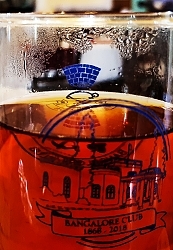
In January 1994, I first visited the Bangalore Club in southern India. A few days before my wedding to a member, my in-laws decided that my hair needed a trim. Back in those days, the Club barber shop was located in a hut behind the Men’s Bar, which until a few years ago did not allow the entry of women and girls. Now renamed, this former bastion of maleness permits all drinkers regardless of their genders.
My haircut was at the very least satisfactory and cost all of 20 Indian Rupees, which was debited to my wife’s club account. In those days one pound Sterling was, if I recall correctly, about 40 Rupees. So, my haircut was remarkably good value compared with what I would have paid for it in London.
At the end of my session with the barber, I fumbled in my pocket to find some money for the tip. All I could find was a 50 Rupees note, which I handed to the man who had looked after my coiffure.
When I related my experience to my wife-to-be, she was horrified that I had tipped more than twice the fee. I suspect that the barber was delighted.



